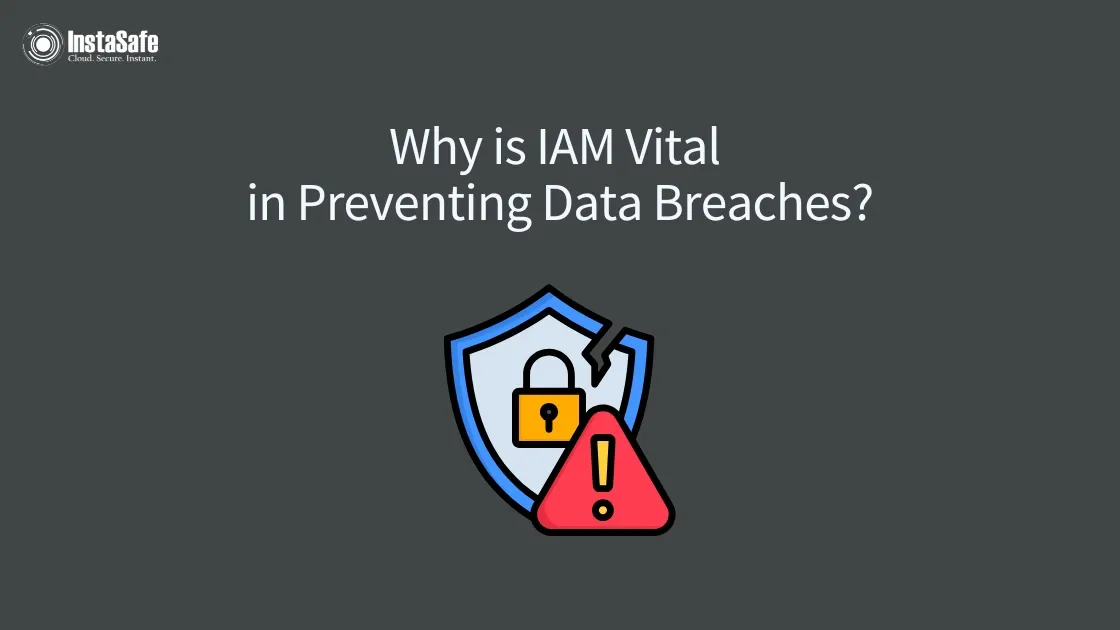Why is IAM Vital in Preventing Data Breaches?

Data breaches happen when hackers steal information from companies. These breaches cost businesses millions of dollars. According to IBM, the average data breach costs a whopping $4.88 million, which is alarming.
Hackers often get in by stealing passwords through tricks like phishing emails. Identity and access management (IAM) is one of the best ways to stop these attacks. IAM makes sure people are who they say they are before letting them use company systems. This blog explains how IAM keeps your data safe and why businesses need it.
What is Identity and Access Management?
Identity and access management is a security system that controls who can access what information in your company. It makes sure only the right people can see sensitive data and use certain programs.
Think of IAM as a guard for your digital building. It checks everyone's ID (authentication), decides which rooms they can enter (authorisation) and keeps track of where they go (monitoring).
IAM systems can be simple or complex, depending on what your business needs. They work for employees, customers and business partners.
How Does Identity and Access Management Help Prevent Data Breaches?
Stronger Authentication Stops Hackers
Modern IAM systems use multiple ways to check who you are before granting access to sensitive information. Instead of just asking for a password, these systems might:
- Send a code to your phone
- Scan your fingerprint
- Check if you're logging in from a new location
- Ask for a special security key
According to Microsoft, this approach, called Multi-Factor Authentication (MFA), blocks 99.9% of attacks. Even if someone steals your password, they still can not access your accounts without these extra verification steps. This helps prevent data breach IAM issues.
Smart Access Control Security
Not everyone in a company needs access to everything. IAM systems let managers decide who can access what information based on their job role. This access control security approach means:
- Sales teams see customer data but not payroll information.
- IT staff access system settings but not financial records.
- Temporary workers receive limited access that expires automatically.
By limiting who can view sensitive data, companies reduce their risk of both external attacks and internal data theft.
Central Management of Digital Identities
Having one central system to manage all user accounts strengthens and simplifies security. When an employee leaves, their access roles are removed instantly across all systems. Similarly, the new hires are provided with the right level of access from day one.
This central directory encrypts identity security information at all times - whether it is being stored, viewed, or sent between systems. This protection helps prevent data breaches even if attackers break through other defences.
Automated Security Monitoring
IAM data breaches often happen when unusual activity goes unnoticed. Modern systems watch for suspicious behaviour like:
- Logging in from new countries
- Accessing sensitive files at unusual times
- Downloading large amounts of data
- Trying to view information unrelated to job duties
When these red flags appear, the system can automatically require extra verification or alert security teams about possible attacks before data breaches happen.
Support for Remote Work Security
With more people working from home, identity and access management becomes even more important. IAM systems let people work securely from anywhere while maintaining strong security through:
- Secure connections to company resources
- Device verification before granting access
- Time-limited authentication sessions
- Location-based access restrictions
These features keep remote work productive without sacrificing the access control security needed to prevent data breach IAM problems.
Key Benefits of Strong IAM Implementation
Improved Compliance with Regulations
Many industries must follow strict rules about data protection. Identity and access management systems help companies meet requirements from regulations like:
- GDPR in Europe
- HIPAA for healthcare
- PCI DSS for payment card information
- SOX for financial reporting
These systems track who accessed what information and when. This helps in creating detailed records that prove compliance during audits and help identify possible data breaches.
Reduced Human Error Risks
Many security problems happen because of simple mistakes. IAM automation reduces these risks by:
- Removing manual permission settings that lead to errors.
- Automatically updating access rights when job roles change.
- Standardising security practices across the organisation.
- Eliminating the need for workers to remember multiple passwords.
This automation lets IT teams focus on bigger security issues instead of spending time on password resets and access updates.
Better User Experience
Strong security should not frustrate users. Modern IAM systems improve the user-experience through the following:
- Single sign-on (SSO) that requires just one login for multiple applications
- Self-service password resets that don't require IT help
- Smooth onboarding for new employees
- Consistent access across devices and locations
When security feels seamless, employees and customers are less likely to look for workarounds that create data breach risks.
Identity and Access Management: The Future of IAM Protection
As threats evolve, identity security systems are advancing with:
- AI-powered risk assessment that adapts security based on behaviour patterns.
- Biometric verification is becoming more common and secure.
- Cloud-based IAM solutions that update automatically against new threats.
- Better protection for non-human identities like APIs and service accounts.
These improvements will help organisations stay ahead of increasingly sophisticated attackers trying to cause IAM data breaches.
Conclusion
Identity and access management stands as a critical defence against costly data breaches. By controlling information access, verifying identities through multiple factors, monitoring for suspicious activity and automating security processes, IAM creates multiple layers of protection.
With proper access control security in place, organisations can dramatically reduce their risk of breaches while still enabling productivity and meeting compliance requirements. As digital threats continue to grow, investing in strong Identity and Access Management solutions becomes not just a technical decision but a business necessity for survival in our connected world.
At InstaSafe, we secure your business data with smart access control. Our identity management stops breaches, makes login easy and protects remote workers, all while saving money and meeting compliance requirements.
Frequently Asked Questions (FAQs)
- Why is IAM so important to keeping information secure?
Identity and Access Management (IAM) restricts system access to authorised users only, preventing data breaches through proper authentication and authorisation protocols that protect sensitive information.
- Why is it important to avoid data breaches?
Preventing data breaches protects sensitive information, maintains customer trust, avoids financial penalties, preserves reputation and prevents business disruption that could result from exposed confidential data.
- Why is maintaining data security vital for an individual?
Data security safeguards personal information from identity theft, financial fraud and privacy violations. Proper IAM implementation helps individuals prevent data breaches and maintain control over their digital identity.
